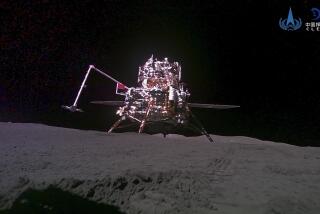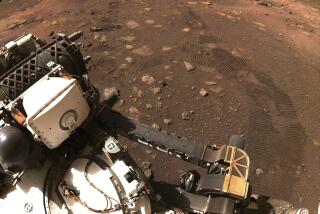14 Nations to Take Part in First Probe of Martian Moon
- Share via
In a challenging mission that ranks among the most important international space expeditions ever attempted, two rockets carrying the work of scientists from 14 countries, including the United States, are to be launched by the Soviet Union next year to make the first landings on a moon orbiting another planet.
According to Soviet scientists who presented details of the mission Thursday at a symposium in Pasadena, the unmanned rockets will carry nearly identical satellites, each equipped with smaller probes designed to study the tiny Martian moon of Phobos.
The plan calls for the first satellite to zip dangerously close to the surface of Phobos and drop two probes to the ground, including a sort of mechanized grasshopper that will jump around, analyzing the soil, until it makes a wrong move and trips or topples over on its side, according to Viatcheslav Linkin, chief of the scientific laboratory at Moscow’s Institute for Space Research.
Because of the weak gravitational force on Phobos, the “hopper” will be able to leap considerable distances, possibly as far as 300 feet, Linkin said in an interview.
The second probe, designed to operate from a stationary position on Phobos, is to carry a television camera and will have to anchor itself to the surface like a boat at a dock because the moon’s gravitational pull is about 1,000 times weaker than the Earth’s.
Impact Problem Reversed
The first satellite will swoop down toward the Martian moon and release the stationary probe at just the right moment, sending it drifting slowly toward the surface. The usual problem in approaching any celestial body is to prevent the craft from crashing into the surface as a result of gravity, but the situation at Phobos will be just the opposite.
“It’s difficult to fix a station (in one location) without gravity,” Linkin said.
To keep the probe from ricocheting across the surface, a small rocket will be fired in the direction away from the moon, plunging the probe into the soil. The probe will immediately fire harpoons into the ground to anchor itself, Linkin said.
The satellite that delivers the probes will have to skirt across the surface of Phobos for about 10 miles--swooping up and down the rugged terrain within about 200 feet of the ground, using radar to guide it.
After the probes have been released, the satellite will blast itself up to a safer orbit and begin studying Phobos in a mission that could last well over a year.
It will use laser beams to evaporate the thin layer of soil on the surface, converting molecules to charged particles that can be analyzed chemically by the satellite. Linkin was quick to point out that the laser will be low-powered, at least 1,000 times weaker than the lasers that the Reagan Administration would like to deploy as part of its Strategic Defense Initiative.
Scientists also hope to learn more about celestial mechanics--the processes governed primarily by gravity that control orbiting bodies--through an experiment aboard the “hopper.”
Before the “hopper” begins jumping around on Phobos’ surface, eventually toppling over so that its antenna no longer points in the right direction, it will release a series of metal balls from the top of a canister inside the probe. The balls will drop to the bottom of the canister--slowly, because of the weak gravitational force--and scientists hope to be able to measure that rate of gravitational acceleration precisely.
That, in turn, should allow them to calculate exactly the strength of Phobos’ gravitational field.
Once they know that, they should be able to predict exactly where Phobos will be a year later. That position varies as much as 50 or 60 feet as the moon orbits Mars, Linkin said.
Theories on Line
If scientists are able to do that, it should help verify some of the theories about celestial mechanics, and should aid in calibrating instruments used to predict orbits, he said.
If all goes according to plan, all of these objectives should be accomplished with the satellite from the first rocket, which should arrive at Phobos in April, 1989. But if any part of it fails, a second satellite with almost identical equipment should arrive a few days later and can pick up where the first one left off. Linkin said that if all works well with the first satellite, the second satellite could be dispatched on to Mar’s other moon, Deimos.
Linkin gave details of the mission during the first International Conference on Solar System Exploration, sponsored by the American Institute of Aeronautics and Astronautics and the Jet Propulsion Laboratory.
International Hardware
The main theme of the three-day conference is international cooperation in space exploration, and scientists pointed to the Phobos expedition as a prime example.
“This spacecraft contains hardware from 14 different nations,” Caltech planetary scientist Bruce Murray said. He noted that in some cases three different nations collaborated on the same instrument.
“That is without precedent in the American program,” Murray said.
More to Read
Sign up for Essential California
The most important California stories and recommendations in your inbox every morning.
You may occasionally receive promotional content from the Los Angeles Times.










